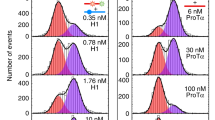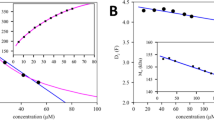Abstract
SEVERAL proteins are dissociated by a change of the hydrogen ion concentration, by adding amino compounds or salts to the solution1,2,3,4 and by exposure to various kinds of radiation5.
This is a preview of subscription content, access via your institution
Access options
Subscribe to this journal
Receive 51 print issues and online access
$199.00 per year
only $3.90 per issue
Buy this article
- Purchase on Springer Link
- Instant access to full article PDF
Prices may be subject to local taxes which are calculated during checkout
Similar content being viewed by others
References
Svedberg, T., NATURE, 139, 1051 (1937).
Svedberg, T., and Pedersen, K. O., “The Ultraccutrifuge” (Oxford: in the press).
Pedersen, K. O., C.R. Trav. Lab. Carlsberg, Sér. Chim., 22, 427 (1938). Steinhardt, J., J. Biol. Chem., 123, 543 (1938). Lundgren, H. P., NATURE, 143, 896 (1939). Andersson, K. J. I. (cf. ref. 2).
Pedersen, K. O., (cf. Jersild, M., and Pedersen, K. O., Acta Pathol. et Microbiol. Sci., 15, 426 (1938).
Svedberg, T., and Brohult, S., NATURE, 142, 830 (1938); 143, 938 (1939). Brohult, S., NATURE, 140, 805 (1937).
Eriksson-Quensel, I.-B., and Svedberg, T., Biol. Bull., 71, 498 (1936).
Author information
Authors and Affiliations
Rights and permissions
About this article
Cite this article
BROHULT, S., CLAESSON, S. Dissociation of the Hæmocyanin Molecule. Nature 144, 111–112 (1939). https://doi.org/10.1038/144111b0
Issue Date:
DOI: https://doi.org/10.1038/144111b0
Comments
By submitting a comment you agree to abide by our Terms and Community Guidelines. If you find something abusive or that does not comply with our terms or guidelines please flag it as inappropriate.



